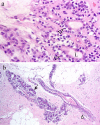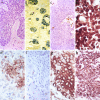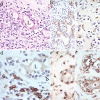Functional Histology of Salivary Gland Pleomorphic Adenoma: An Appraisal
- PMID: 25380577
- PMCID: PMC4542802
- DOI: 10.1007/s12105-014-0581-1
Functional Histology of Salivary Gland Pleomorphic Adenoma: An Appraisal
Abstract
The complex microstructure of salivary gland pleomorphic adenoma is examined in relation to function. Events related to secretion of macromolecules and absorption, responses to the altered microenvironment and controversies concerning epithelial-mesenchymal transition versus modified myoepithelial differentiation are explored. Their effects on tumor cell phenotypes and arrangements are emphasized. Heterotopic differentiation and attempts at organogenesis are also considered. The approach allows interpreting microstructure independently of histogenetic perceptions, envisaging the tumor cells as a continuum, endorsing luminal structures as the principal components, and defining pleomorphic adenoma as a benign epithelial tumour characterized by variable epithelial-mesenchymal transition, secretion/differentiation and metaplasia.
Figures



































Similar articles
-
The involvement of growth differentiation factor 5 (GDF5) and aggrecan in the epithelial-mesenchymal transition of salivary gland pleomorphic adenoma.Rom J Morphol Embryol. 2013;54(4):969-76. Rom J Morphol Embryol. 2013. PMID: 24398992
-
The importance of BMP6 marker within the process of epithelial-mesenchymal transition in the pleomorphic adenoma of the salivary gland.Rom J Morphol Embryol. 2017;58(1):145-151. Rom J Morphol Embryol. 2017. PMID: 28523310
-
Immunohistochemical localization of members of the transforming growth factor (TGF)-beta superfamily in normal human salivary glands and pleomorphic adenomas.J Oral Pathol Med. 2001 Aug;30(7):413-20. doi: 10.1034/j.1600-0714.2001.300706.x. J Oral Pathol Med. 2001. PMID: 11488419
-
[Pleomorphic adenoma of salivary glands: diagnostic pitfalls and mimickers of malignancy].Cesk Patol. 2012 Oct;48(4):179-83. Cesk Patol. 2012. PMID: 23121026 Review. Czech.
-
Ultrastructural contributions to the study of morphological differentiation in malignant mixed (pleomorphic) tumors of salivary gland.Head Neck. 1989 Jan-Feb;11(1):5-21. doi: 10.1002/hed.2880110104. Head Neck. 1989. PMID: 2537801 Review.
Cited by
-
Pleomorphic Adenoma of the Salivary Glands and Epithelial-Mesenchymal Transition.J Clin Med. 2022 Jul 20;11(14):4210. doi: 10.3390/jcm11144210. J Clin Med. 2022. PMID: 35887973 Free PMC article. Review.
-
Atypical and worrisome histological features in pleomorphic adenoma: challenging and potentially significant diagnostic pitfall.Virchows Arch. 2025 Jan 18. doi: 10.1007/s00428-024-04015-z. Online ahead of print. Virchows Arch. 2025. PMID: 39827206
-
The Transcriptomic and Gene Fusion Landscape of Pleomorphic Salivary Gland Adenomas.Genes Chromosomes Cancer. 2025 Jan;64(1):e70023. doi: 10.1002/gcc.70023. Genes Chromosomes Cancer. 2025. PMID: 39812386 Free PMC article.
-
Pleomorphic adenomas of the salivary glands: retrospective multicentric study of 130 cases with emphasis on histopathological features.Eur Arch Otorhinolaryngol. 2017 Jan;274(1):543-551. doi: 10.1007/s00405-016-4253-5. Epub 2016 Aug 12. Eur Arch Otorhinolaryngol. 2017. PMID: 27520570
-
WNT5B drives osteosarcoma stemness, chemoresistance and metastasis.Clin Transl Med. 2024 May;14(5):e1670. doi: 10.1002/ctm2.1670. Clin Transl Med. 2024. PMID: 38689429 Free PMC article.
References
-
- Hand AR. Functional ultrastructure of the salivary glands. In: Sreebny LM, editor. The salivary system. Boca Raton: CRC Press; 1987. pp. 43–67.
-
- Masson P. Human tumors. Histology, diagnosis and technique. 2. Detroit: Wayne State University Press; 1970.
Publication types
MeSH terms
Supplementary concepts
LinkOut - more resources
Full Text Sources
Other Literature Sources
Medical

